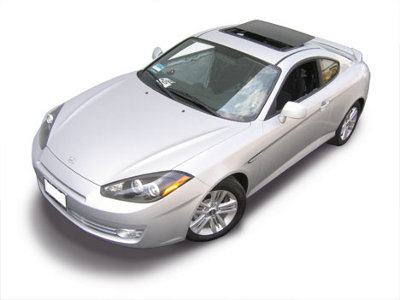Tiburon Exhaust Videos
- 1999 Hyundai Tiburon Exhaust Systems
- 2000 Hyundai Tiburon Exhaust Systems
- 2001 Hyundai Tiburon Exhaust Systems
- 2002 Hyundai Tiburon Exhaust Systems
- 2003 Hyundai Tiburon Exhaust Systems
- 2004 Hyundai Tiburon Exhaust Systems
- 2005 Hyundai Tiburon Exhaust Systems
- 2006 Hyundai Tiburon Exhaust Systems
- 2007 Hyundai Tiburon Exhaust Systems
- 2008 Hyundai Tiburon Exhaust Systems
Tiburon Exhaust System Tips

The very first Hyundai model to offer a semblance of sportiness and thereby excitement for enthusiasts was the front-wheel-drive Tiburon coupe. This model was sold in the United States from 1997 to 2008 and began Hyundai’s quest to transform itself into a producer of bland, economy cars into a broader range of vehicles including luxury sedans and sport coupes.
Indeed, today’s Hyundai Genesis coupe is nothing like the Tiburon, but without the Hyundai Tiburon this model would never have been produced. Let’s give credit where credit is due: the Tiburon, which is Spanish for shark, served the compact coupe segment well for two generations, delivering an affordable and practical alternative to the Honda Civic coupe, Mazda 3 and the Nissan Sentra coupe.
First Generation
When introduced in 1997, the Tiburon replaced the Scoupe, Hyundai’s failed attempt at producing a worthy tuner showpiece. That model was based on the Hyundai Excel, a Mitsubishi-derived compact and the first Hyundai sold in America.
Where the Scoupe left everyone wanting more, the Tiburon began to show that Hyundai was serious about the sport coupe market. Initially powered by 1.8- and 2.0-liter four cylinder engines paired with 5-speed manual transmissions or optional 4-speed automatic transmissions, this model was carved out of the Elantra, a Hyundai-inspired and crafted compact model.
Producing 130 horsepower in base form and 140 horsepower in the FX, the Tiburon easily outpaced the Toyota Paseo in power and price, offering similar power as found in the Dodge Neon although trailing Honda and Nissan in quality. For its last two year of production, the first generation Tiburon offered just one trim level and one engine: the peppy 2.0-liter four.
Second Generation
By the time Hyundai got the second generation Tiburon to the market, the 2002 model year came and went without a sport coupe to sell. But, the wait was well worth it because the new model added fresh styling and an optional V-6 engine to go with the base 2.0-liter four. The Tiburon GT, powered by a 2.7-liter 24-valve V-6 and paired with a 5-speed manual, is rated at 170 horsepower at 6,000 rpm and 181 foot-pounds of torque at 4,000 rpm.
Finally, the “Tib” was a legitimate sport coupe, challenging everything from V-6 Mustangs to Accord coupes. Priced under $20,000, the Tiburon GT was visually appealing and an excellent car for enthusiasts looking for value and a customizable ride.
After a 12-year run, the Tib is no more, but fan forums are alive with owners who are turning and modifying their four and six cylinder rides. Hyundai Tiburon superchargers are popular as are sway bars to improve handling and, of course, performance exhaust systems offering a unique note suitable for any Tib.
There are a few companies producing exhaust systems for the Hyundai Tiburon:








